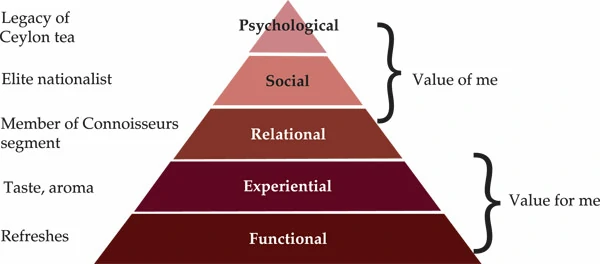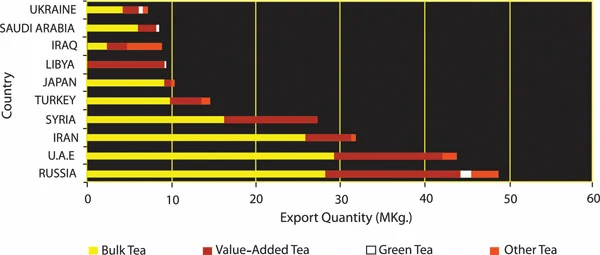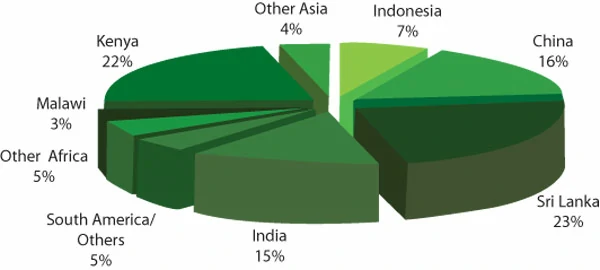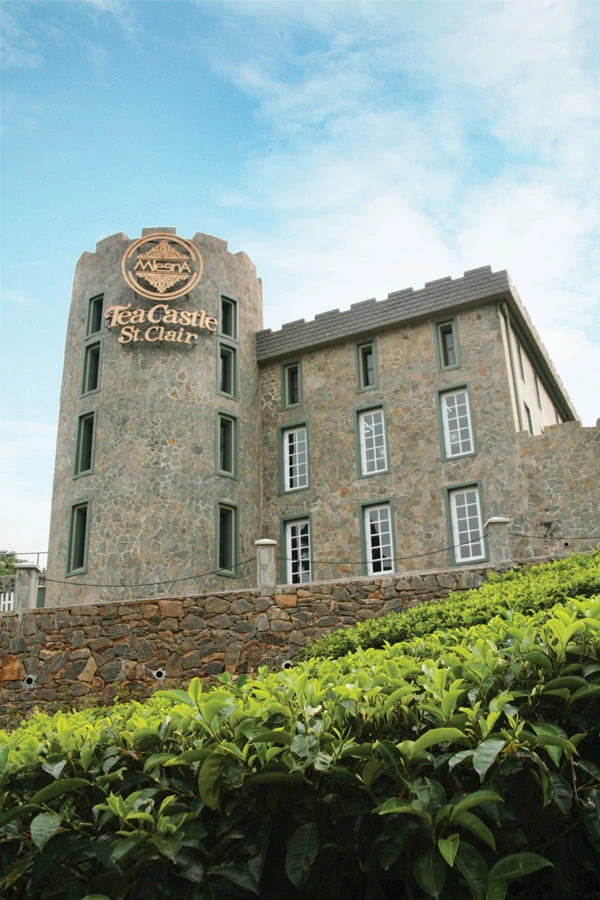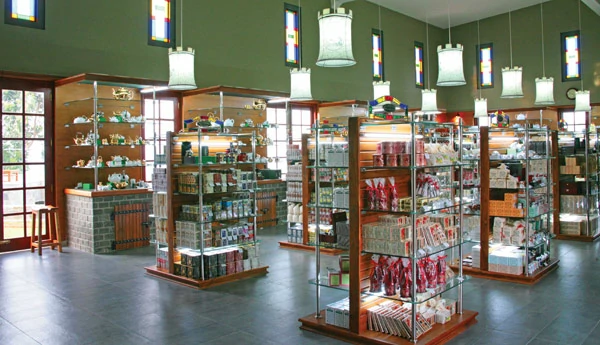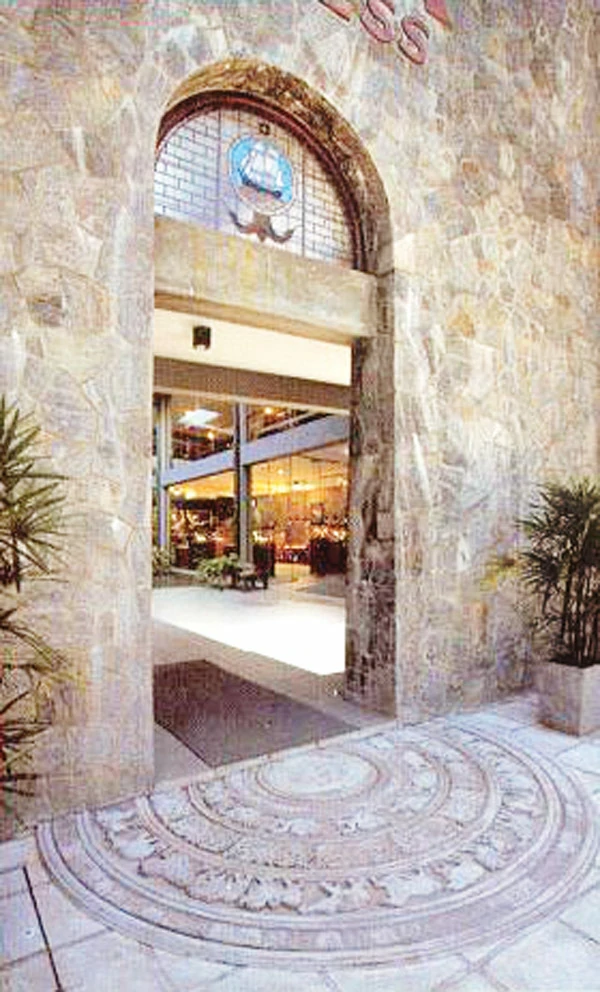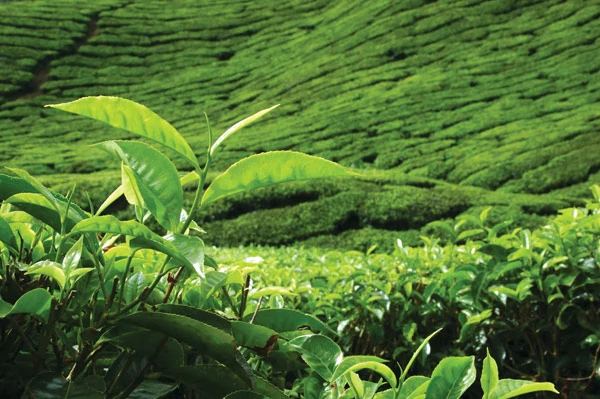
W D Lakmini Prematunga (MCIM ) MBA(Sri J)
Source: Sri Lankan Journal of Management Vo 14, No 3, July-September, 2009 of the Postgraduate Institute of Management, Colombo
1.Introduction
Ceylon tea stands for the cleanest and best quality tea as Sri Lanka is the first country in the world to be awarded the ozone friendly status and it has the lowest pesticide residue of all the teas in the world.
Since the inception of Ceylon tea, the tea trade has been exporting the commodity to consumer markets. In the last three decades, a serious transformation into value addition for the export of finished consumer packed tea has enhanced the export income of the tea industry through tea centres.
Kenya, India, China and Indonesia are competing with Ceylon tea and following the lead given by Sri Lanka.
Abstract
This case study reveals the legend of “Mlesna” speciality tea and digs deeper into how Mlesna created a distinctive position, which led to a world-renowned brand name in the “Ceylon Tea” commodity market in the local and international arena. The paradox of the fact is that this brand virtually created a centuries-old mood and tone, which still appeals to the new consumer.
Mlesna Tea revolutionised the local traditional tea export from bulk raw material and cheap consumer packs to a more lucrative form of exclusively finished consumer and gift packs. While all other Ceylon Tea players were competing within the low-end market segment whilst catering to the masses with bulk tea or value for money teas, Mlesna realised the impact of eroding margins of such a market and anticipated the requirement to seek for new markets, in order to combat cut-throat competition. Having identified their core competences, Mlesna Ceylon Tea decided to add value to the raw leaf of Sri Lanka instead of merely selling it as a low-priced raw tealeaf to major foreign purchasers. They were the first Sri Lankan tea company to introduce the specialty tea concept to Ceylon Tea and thereby shunned the commodity “bulk” tea exporters and value added Ceylon tea. They also introduced lifestyle retailing which is a novel concept in Sri Lanka. Today Mlesna stands as a hallmark of quality tea both locally and internationally and has won 79 awards, which consists of 19 Presidential Export Awards, 11 National Export Awards, 23 Lanka Star Awards, 17 Asia Star Awards and nine World Star Awards.
Intermediaries from importing countries have been adding value to bulk exports and earning higher margins for Ceylon tea. The tea market is one battle field in which almost all the local players battled for a share through brand supremacy.
They focused on:
ï€ Benchmarking the competition and competing on price-value for money;
ï€ Offering bulk tea focusing on big volumes and lower grades of tea;
ï€ Catering to the traditional mass market (lower and middle income categories);
Ceylon Tea has been slower than other beverage categories to capitalise on the trend toward branding (i.e., Coca-cola).
2. Sri Lankan Tea and the Global Market
Sri Lanka exports approximately 95% of its production and has been able to maintain its global export share at 20 – 21%. Today its export profile has gone through a significant development to cater to the changing needs of the consumer.
The product range that is exported by Sri Lanka includes black tea, green tea, organic tea, instant tea and flavored tea, and RTD tea products. Sri Lanka exports a larger quantity of tea packets and tea bags to add value to its tea than any other tea producing country in the world. According to data available of Sri Lanka tea exports up to October 2008, the country has exported 268,664 MT of tea at a value of Rs 118.2 billion compared to 257,807 MT and Rs 91.3 billion recorded for the same period in 2007. It appears that the final export volume for 2008 will reach 300,000 MT and its value will exceed Rs 125 billion.
Many Sri Lankan players contribute to the total volume of exports of Sri Lankan tea.
The Revolution in the Tea Industry – From Bulk Tea to Value Added Tea
The few counties which made progress in value added tea are Sri Lanka, India and Kenya. The fact remains that these countries had seen the potential in value addition fairly late with Sri Lanka giving the lead.
Ever since then, value added tea has taken a national perspective. It has helped embody its contribution of the industry to the welfare of the nation, in terms of foreign exchange earned, employment generated and general improvement in the quality of life that the industry was able to create. This value added tea enables the exporters to charge a larger margin for the same quantity of tea sold.
Figure 3 gives an overview of value added tea exports along with bulk exports over the last three decades. It depicts steady growth over the first decade, and then a balance run of 30% from the total export volume.
Sri Lanka is also the largest producer cum exporter of value added teas in the world. Colombo, the commercial capital of the country, boasts of the greatest concentration of tea bagging capacity in any city. The range of value-added products extends from packets, tea bags in its entire range, specialty and gift tea packs to a fine range of flavoured teas.
What many connoisseurs of tea around the world are not aware of is that their favourite brand of tea has been enhanced by a percentage of Ceylon tea. The more astute blenders and tea packers around the world have always known the value of fine Ceylon teas and used it to enhance blends of other origins. The annual tea production of Sri Lanka has moved up to approximately 320 million kgs today and accounts for nine percent of the global tea output. The contribution from the smallholder tea growers sector is the main reason for the increase in the output of tea. Over the years, Sri Lanka has earned a reputation as a producer of high quality tea and Ceylon Tea is synonymous with quality and taste.
The strength of Sri Lankan tea lies however not merely in the volume of production, but also in its superlative quality and taste. Sri Lanka is an exception, and has succeeded in capturing more value in the supply chain through value-added production.
3. Sri Lankan Tea Market
The local value added tea market is led by multinational players and small holders. Lipton, Laojee, Watawala, Bogawanthalawa, Theja and John’s Tea are a few names, which are leading the market in low-end consumer segments. All of these brands cater to low and middle income category consumers, who purchase tea for value for money. Brands such as Tea Tang, Zesta and Dilmah cater to the upper middle segment of the mass market. In addition to these players, there are plenty of small time cottage tea players who sell unbranded/loose tea.
It is in this context that the author explores the branding strategy of Mlesna Tea, which is a symbol of success in the local and international tea market.
4. Methodology of the Study
This study is based on interviews with the Chairman, senior management and staff of Mlesna, results of a consumer survey, field visits to factory and key outlets, information gathered from industry specialists and secondary data (ICT Bulletins, referencing Tea Board library and Chamber of Commerce books, paper articles, and the Internet).
Euro Scan Exports entered the “Ceylon tea” battleground in an unstable context when the conflict had just begun. It had a very humble start as a small family business in the owner’s garage and now the brand Mlesna is competing with world-renowned multinational brands and has become the role model in the local tea retailing business.
5. Visionary Leader
Anselm Perera, Chairman of Euro-Scan, started his career as a trainee tea taster at Brooke Bond Ceylon just after schooling. During his nine and half years there, he got the opportunity of going to the UK and working for a short time in Pakistan. From there, he moved to Shaw Wallace and Hedges as a Tea Manager and within two years, he was promoted as the Tea Director. He had learnt everything from them – blending, packing, tea tasting, and the entire business. He implemented all those practices and learning and his international exposure as the basis for his business and the rest of it he developed as the business progressed.
Euro Scan Export company was established in 1983 with a 16-member team at his own garage just two weeks before the crisis. His brand name was derived from mirroring his name. Anselm Perera understood the consumer’s thirst for better quality tea, which needed to be unique in taste and flavour and presented this combination in a manner that reflects in the purity and quality of Ceylon Tea. Perera’s vision is to make the tea-drinking habit more popular locally as well as internationally, among all age groups and thereby expand the market.
He took the leadership of transforming the traditional bulk tea exports to marketing sophisticated value added branded teas, popularly known as Pure Ceylon Tea in the local and international arena. Perera converted consumers’ Trust in Ceylon Tea to his business’ advantage by linking the advantage of county of origin into the tea brand that he sells.
He also has unbounded energy to scan world markets for new niches like a prospector mining for gold. For him every nugget is hoarded. At the discussion the author had with him, he stated that he would go after a small order such as 2,000 numbers. He is a maverick who tries out new flavours and reaches market segments, which Sri Lankans have not approached before. Further, he raised the standards of the local Ceylon tea industry by giving a novel experience to travellers with a thematic life style retail concept. He used his passion for creativity to embark on his business journey. He changed the image of black tea to value added products. It is very well demonstrated in the way Mlesna is positioned with a set of unique characteristics, which has strengthened the brand name of “Ceylon Tea” in identified market segments.
Today Perera is the Chairman /CEO of the Euro-Scan Group of Companies and is a pioneer and forefather in the field of value added flavored teas, packaged gourmet and gift products. He is at the forefront of the tea industry as one of the most experienced tea tasters in the country. His contribution to the industry is immense, as he has contributed to the country’s exports and exposure of Sri Lanka as a country producing quality gourmet specialty teas capable of innovating superior products with exclusive designs.
6. Mlesna’s Six Path Framework for Value Innovation
The success behind the brand Mlesna can be illustrated by applying Blue Ocean strategy as discussed by W Chan Kim and Renee Mauborgne.
7. Findings-Mlesna’s Blue Ocean Brand Mantra
Look across strategic groups within the industry
Mlesna attracted a whole new group of customers who were traditionally non-customers in the industry. They were high-end customers prepared to pay several times more than a typical housewife for the offerings. The majority of this segment includes overseas travellers, individuals who travel on holiday, private sector corporation personnel who travel for business purposes, key government stakeholders and VIPs representing the country and expatriates. Within this segment, it is the “connoisseurs” segment that they have looked at. A connoisseur (Fr Connoisseur, from Middle-French connoistre, then connaître meaning “to be acquainted with” or “to know somebody/something.”) is a person who has a great deal of knowledge about the fine arts, or an expert judge in matters of taste. Source: www.wikipedia.org.
The author has conducted research and identified certain segments as illustrated below. It was proved that the majority of Mlesna consumers fall into the category of Connoisseurs.
Look across alternative industries
Mlesna looked across the market boundaries of TEA. They created an uncontested market space for “Ceylon tea” by exploiting the distinctive strengths of other alternative industries such as hospitality (restaurants) and tourism (handicrafts) to offer a totally new set of utilities to connoisseurs and up market customers. Mlesna offered this segment a superior quality product with unique flavours and wrappings. Be it black or green, consumed plain or with milk, “Mlesna” gives the world unmatched quality teas which the connoisseurs would always consume.
Look across functional and emotional appeal
Mlesna did not attempt to be better than competitors like most of the global “Ceylon Tea brands; they were rather different to competitors whereas most of the “Ceylon tea” players try to steal market shares from each other by operating in the mass market and positioning themselves in the “value for me” category of the customer value pyramid.
Mlesna upgraded the quality of tea in terms of introducing variances of flavours and aromas. They created a new stake in the niche market by positioning themselves in the “Value of me” (sign value) drivers in the customer value typology. Mlesna stands for “gift tea.” In doing so, they captured the more affluent up market connoisseur segment of buyers who would prefer the artistic. Mlesna projects a brand personality of an elite nationalist, and it reflects a legacy of Ceylon Tea to its target market.
The creative element of the brands implementation clubbed with the finest and most intricately differentiated flavours of the product itself is what makes Mlesna what it is. Functionally and experientially, the brand refreshes and creates a unique atmosphere. On an emotional level, it makes one feel like a connoisseur and thereby becomes a connoisseur. Socially and psychologically, Mlesna evokes elitist nationalism along with the heritage and legacy of what classic Ceylon tea really is. That is more than most brands have achieved in a century of existence. The paradox of the fact is that a virtually new brand can create the mood and tone going back to centuries and still appeal to the new consumer.
8. Brand Positioning
Mlesna positioned themselves as a specialist in the gift/souvenir tea category. It was not just tea with Mlesna; it was tea with substance, which caters to connoisseurs. They offer the finest “Ceylon Tea” in very innovative exquisite form of gift-wrappings, which are collectors’ items for connoisseurs across the globe (Brand Promise – “Naturally the best”).
Mlesna’s tea gifts are for “connoisseurs” across the world who want to have a fine blended tea, and those who want to give away a Sri Lankan souvenir/handicraft to their friends and colleagues. Mlesna offers the finest “Ceylon Tea” in a very innovative exquisite form of giftwrapping which are collectors’ items for connoisseurs. Their team consists of tea experts with over 30 years of industry expertise. They have won 76 awards, which include Presidential and World Star awards for excellence in quality and packaging.
9. Ingredients of Branding
Mlesna has gone beyond the conventional norms of a brand because of many of the finer aspects of branding and consumer connection coming together in a perfect blend. Their brand strategy was to transfer the trust and credibility of “Ceylon Tea” to their brand by bringing together the upper crust element of British Colonialism, local cultural connotations, and the use of various types of local artistry, traditional craftsmanship and local materials to create their packaging alone for instance. This is merely the tip of the iceberg when it comes to Mlesna coming together as an icon. With Mlesna, tea was not just a beverage but a “total experience” of Sri Lankan heritage, culture and history in a pack of tea.
Look across time and trends
Classic Packaging -Talking the Language of the Connoisseurs
Mlesna has a wide range of tea pack designs at a wide range of prices to suit the connoisseurs. Their gift packs provide a wonderful range of unique tea gifts for any enthusiast. Unique tea gifts such as pots and kettles can range from $24 – $100 and more, depending on craftsmanship and the materials.
This packaging varies from cloth bags/sacks, small wooden chests, and reed boxes to ornately made ceramic containers in very different shapes such as animals (elephant, turtle, frog, cat, dog and rabbit. Moreover, packs include a variety of teapots, books, fancy wooden boxes, metal cans, figurines, paperboard cartons, leather packs, triple laminated packs, and reed and cane baskets, cloth sachets to satisfy even the weirdest of tastes as well as 22 – carat gold/ bronze/platinum plated containers for the up market customers.
This novel concept of exporting tea in a wide range of attractive packs is purely the entrepreneur’s idea. He created a sensation by bringing traditional craftsmanship and fine art to the tea trade. By exporting the finest blends of Ceylon Tea in a most exquisite selection of consumer and souvenir packing that addressed the connoisseurs brought a new dimension to this century-old industry.
Just as tea has grown to be Sri Lanka’s most prestigious export product, Mlesna’s packaging plant at Mlesna House has evolved to meet modern demands of packaging over the years. They upgrade their packs and constantly change their designs before somebody else imitates.
Look Across the Complementry Offering
Lifestyle Retail Stores Concept – A Unique Way to Reach the Connoisseurs
Mlesna continued their journey by identifying ways and means of complementing the superfine tea, which they had been blending. Because they offer superior quality gourmet products, their gift teas are not served in normal cafes or sold in general trade, as the company does not want to compete on prices with other tea brands. They are the first to introduce the “Tea Centre” or “Tea Kiosk” concept, which is unique to Sri Lanka yet on par with world standards, Furthermore, Anselm Perera of Mlesna presented a vivid description of the revolution of the country’s tea industry linking the old tea boutique (village tea shop- game kopi kade) to the modern Tea House.
Mlesna envisaged a chain of exotic teashops, where people can relax and socialise, differentiating Mlesna from coffee shops that had been already established in the last decade. With the new trend of healthy lifestyle they believe tea to be more popular than coffee. This tea boutique concept quickly gained a huge popularity in Sri Lanka. It also attracted tourists, visiting delegates and the up-market tea drinking community in Sri Lanka. These teashops also house a wider array of premium quality gourmet teas in award winning packaging.
Lifestyle retail marketing is playing a growing role in the selling of tea. Traditional teahouses were growing in sophistication and new forms like tea bars and tea kiosks had emerged. These outlets offer a modern ambience to attract sophisticated, young consumers in the same way as coffee bars. The new generation, which recognises quality, is willing to pay a premium for a superior quality product.
Mlesna needs no promotion in Sri Lanka; it is synonymous with the best blends of tea. Their outlets themselves are a creative masterpiece and an advertisement by itself. The building structure is based on the theme of the “Old Fort.” Mlesna’s brand values of “Quality”, “Cleanliness”, “Creativity” “Class” and “Prestige” are reflected in the architecture, interior designing and the offerings (food and beverages). It is a memorable and unique experience for both locals and foreigners. Its exclusively decorated teashops create an ambience that is unique and offer an experience that defines the very essence of its product quality.
The Mlesna brand name has sprouted a unique leaf and its branches now continue to blossom in all their glory. Currently Mlesna has 18 outlets island wide and 47 outlets overseas. Interestingly this entire set of channels reflects a similar brand identity.
10. Snapshots of Interior and Décor -Mlesna’s Tea Fortress
Backdrop of the building consists of a large mural depicting the olden day’s methods of tea transportation and tea harnessing. From beneath the mural flows a water-creek right into the central pond in the main lobby area The Tea Fortress is not a mere stop to shop or a quick cup of tea. It is an experience one can select a cup of tea from a range of unimaginable varieties and flavours, pick a gift or a souvenir for yourself from a wide array of quaint but useful items, purchase or order a piece of exclusive jewellery, have a snack or meal prepared to perfection, it is an experience that is personalised and one that should not be missed. At the discussion the author had with Perera, it was discovered that this was a pet-project of his; he had been involved actively from the stage of designing the building, which is awesome from outside as well as inside. “The creation of the Tea Fortress is a dream come true” for Anselm Perera.
11. Superior Quality
Mlesna with expertise in tasting and blending for many years creates the finest blends in the world. Arrays of gourmet and gift teas are offered to markets around the globe. “Superior Quality” is the philosophy which management adopts from the purchase of raw leaves right throughout the value addition process till tea is purchased by the consumer.
Mlesna offers an extensive range of teas, spices, herbs and certified organic produce. They are superior quality, unique in its taste and flavour. Its master blenders and tea tasters create an exact match for almost any tea sample you provide or even create a unique blend.
High quality teas are selected by the tea tasters. They go to the extent of brewing tea with water of the desired destinations. Constant flavour checkups and assessments are done in the factory and head office in order to minimise the variations in the original formula, which is developed by the entrepreneur. Each tea bag is flavour sealed in triple laminated vacuumed foil envelope to help retain freshness and fragrance. Finished goods are adequately stored and delivered on time across the globe. Moreover, Mlesna also focuses on how the end product is received by the customer at the point of purchase by having consumer feedback mechanisms as well. ISO 22000/5000-2005, GMP standards of manufacture, World Star Award packaging standards are followed at the Mlesna factory.
12. Entrepreneurial Spirit and Passion
The company is centrally driven by the Managing Director’s entrepreneurial spirit. According to Perera, his business practices go beyond competing with each other in the industry. He stated, “a competing strategy’ is rooted in nowhere.” His company, therefore, values innovation without adhering to industry structure and market boundaries. He drives the company to create temporary monopolies.
His over two decades of tacit knowledge gives a cutting edge to selection, brewing and packing the best quality tea for the palates of global consumers. Perera formulates recipes and sets the standards for each flavor, which is then communicated down the line.
His eagerness to take risks is well demonstrated by his strategic actions:
- ï€ Company initiated in 1983 with the onset of the crisis;
- ï€ Broke away from traditional commodity tea marketing by offering value added finished tea products;
- Ventured into the exclusive tea boutique concept in Sri Lanka and overseas;
- Offered a diverse range of flavours and products.
Perera directs his team to accept the passion and commitment of the leader in delivering superior quality products/services to buyers with flair and a passion to market the quality creations with dedication and commitment. This is the key to the entrepreneur’s leadership.
The author’s one-to-one discussion held with representatives of the company reflected that his company is open to new ideas, and it invests heavily in new technology to upgrade the standards; yet they do not want to change the business practices, which they had been continuing such as reliability, honesty, British business ethics and discipline, attention to detail, and painstaking preparation before implementing strategies. Be it the head office, factory or a boutique, everywhere management drives the philosophy of attention to minute details.
13. Novel Product Range
Mlesna’s product range extends beyond the normal consumer packs of loose tea and tea bags to speciality teas, flavoured teas, special catering products and a large array of gift teas and tea accessory products.
The range of packaging extends from paperboard cartons, soft wood and hard wood boxes, leather products, cloth bags, porcelain caddies, teapots, figurines, gold and platinum plated exclusive high-end gift teaware to a variety of innovative caddies, jars, and presentation products, which develop into the creation of specialties.
Mlensa’s own blends have endless choices from loose leaf to tins. The final product is presented to exceed the reseller’s and final consumer’s expectations. For example, polpala (Aeura Lanata) is a herb indigenous to Sri Lanka famous for its kidney nourishing and diuretic properties. Mlesna adopted polpala to its spice beverage range. A blend of green tea and polpala (Aeura Lanat) has been created for those who prefer soothing herbal tea that is totally devoid of caffeine. This can be drunk at anytime of the day, and can be consumed either hot or cold. There are other local fruity flavours like Eastern Soursop (katu atha) and pomegranate (delum), which are unique to Sri Lanka.
14 .Efficient and Superior Services
Mlesna caters to all age groups and specific ethnic demands of taste and culture. They do creative adjustment of blends and flavours to suit the different lifestyles and food habits of the varying markets. As a result, Mlesna has gained an edge over competitors.
At the discussion the author had with the management it was revealed that the company believes that it is very important to keep a content staff in order to strive for excellence. Management ensures providing benefits and working conditions that enable their workforce to be content. The company provides the employees with incentives for the best performers as an ongoing process. It also gives regular training to the employees and rewards those who demonstrate improved performance. For instance, the best performer is given an annual valuable prize, which makes the employees constantly try to improve their standards. Thus, it is clear that hard work and gratitude to those who assist in the enterprise are the pillars of success.
Their staff is well trained and groomed to service the target market. They give prompt attention to customer needs. Each staff member at the head office, factory or outlets provide efficient buyer friendly deliveries in their own way to please customers/clients, giving them further additional support in the market place.
15. Conclusion
Mlesna transformed Ceylon tea, which was a commodity into a speciality market by concentrating on the higher grades of quality tea. They pioneered the creation of an uncontested market space by capturing a sophisticated target market, which is the connoisseurs segment.
They positioned themselves in the gift tea category by making the offering appealing to the desirable target market segment. They built a super brand by transforming the brand values of pure Ceylon tea. A new flavour to the tea industry was given by blending it with British colonialism, cultural connotations and artistry. Mlesna brought in many of the finer aspects of branding and consumer connection coming together in a perfect blend. With Mlesna, tea was not just a beverage, but also a “total experience” of Sri Lankan heritage, culture and history in a pack of tea. They thereby added a sense of Sri Lankan taste to the offering. At the point of executing or creating a new value curve in the tea industry, Mlesna revamped the traditional marketing mix (value delivery elements) by emphasising the classic packaging, retail lifestyle stores concept, novel product range and efficient and superior service.
Mlesna Ceylon’s pillar of brand success is no doubt the entrepreneur’s flair for creativity and innovativeness together with his decades of tacit knowledge of the tea industry. However, in time to come the company should transfer the above-mentioned entrepreneur’s values to the next generation of management, strike a balance between the contemporary and colonial, while conceptualising new flavours and packs to suit the connoisseurs’ markets.
References
Daily Mirror/August 18th 2008
Explore Sri Lanka-February 2009 dedication
http://www.Mlesnateas.com, last accessed on 20/12/2008
http://www www.ceylonteaboard.com, last accessed on 18/12/2008
http://blog.contextbranding.co.za/evolving_brands/brand_culture_/ last accessed in 20/12/2008.
http://www.affno.lk/high_end_websites/clients_detail/Mlesna.htm last accessed on 18/12/08.
http://www.managementtoday.co.uk/search/article/547967/blue-ocean-strategy-createuncontested-market-space-competition-irrelevant, last accessed in 18/03/09
http://www.kellysearchasia.com/sg-company-900243652.html last accessed on 10/2/2008
International Tea Committee bulletin/ 2007
Liyanage U.P, Tangibility as a mental construct: implications for products
Liyanage U.P, Differentiation: The Quintessence of Strategy/2008
Lanka Woman/ February/ 2009
Postgraduate of Management, Sri Lanka Journal of Management, Volume 12 No 3 &4 July, December 2007
Soloman Michel R., Consumer Behavior, Sixth Edition, 2006.
www.affno.lk/high_end_websites/clients_detail/Mlesna.htm – 19k – Cached – Similar pages
last accessed in 02/02/2009
http://www.allbusiness.com/marketing-advertising, last accessed in 12/3/09
http://ceylon-tea.blogspot.com/2007/09/mlesna-tea-finest-ceylon-tea.html,http://
www.syl.com/travel/mlesnateabagsofferingavarietyoffragrancesandflavors.html, last accessed 01/02/09
http://www.nutraingredients.com/Consumer-Trends/Specialty-tea-market-boosted-by-healthbenefit-claims, last accessed 03/03/09
http://www.statistics.gov.lk,Census.lk last accessed in 03/01/2009
W Chan Kim/ Renée Mauborgne, Blue Ocean Strategy, how to create uncontested market
space and make competition irrelevant, Harvard Business School Publication/2005
